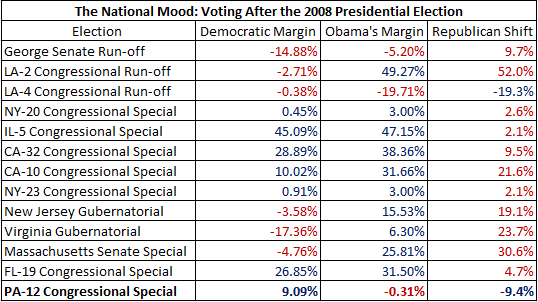By: Inoljt, http://mypolitikal.com/
On Tuesday night Pennsylvania’s 12th congressional district held a special election, pitting Democratic candidate Mark Critz against Republican Tim Burns.
Mr. Critz won solidly: a nine percent margin of victory off 53.4% of the vote. Several polls had predicted a very close, photo-finish election; this result contradicted that assumption.
This victory constitutes good – very good – news for Democrats.
More below.
His district, PA-12, was one of the few countrywide that voted more Republican from 2004 to 2008, as the rest of the nation shifted substantially left. Districts such as these are prime targets for Republicans in 2010.
Indeed, PA-12 constituted the only seat in the entire nation that supported Senator John Kerry and then switched its vote to Senator John McCain. For reasons such as this, I wrote a week ago that:
It will be a minor miracle if Democratic candidate Mark Critz wins. [Almost] no Democratic candidate has ever done better than Mr. Obama since his election. Mr. Critz will have to do that, given that the president lost PA-12 (the only seat in the nation to support Kerry and the McCain). In a district with double-digit disapproval ratings of Mr. Obama, this constitutes an arduous task.
As it turned out, Mr. Critz did far better than Mr. Obama. Indeed, his victory constitutes the first time a Democratic candidate has improved on the president’s performance since December of 2008, when Democrat Paul Carmouche barely lost LA-4 to Congressman John Fleming.
Mr. Critz won by appealing to local issues, emphasizing his independence from the president, and sounding like a fiscally liberal, socially conservative Democrat – the type of Democrat places like PA-12 have traditionally voted for.
This is a strategy that Democrats have long used, to great success, in winning congressional districts that they should not be winning. It is how both Mississippi and Arkansas elect three Democratic versus one Republican congressional representative, and how Texas elected more Democratic than Republican congressman right until 2004. It is partly how the party won such great congressional victories in 2006 and 2008.
There has been much fear amongst Democrats that, in light of Mr. Obama’s presidency, this strategy will no longer work. State Senator Creigh Deeds tried running a rural-style candidacy for Virginia’s governorship; he failed quite miserably.
Mark Critz, on the other hand, succeeded where many – including this individual – thought for sure he would fail. His performance certainly does not mean that Democrats are in for an easy time come November, but it does give the party something to work with in the tough days ahead.




